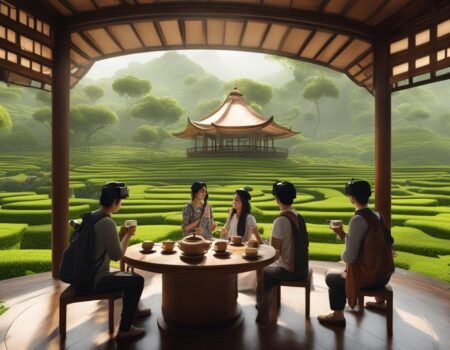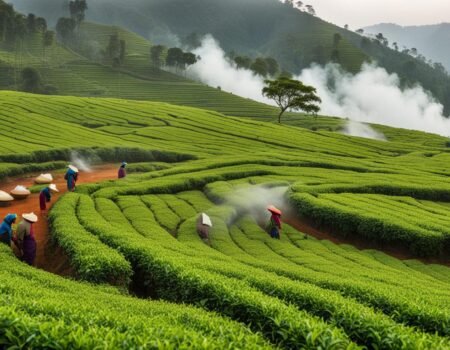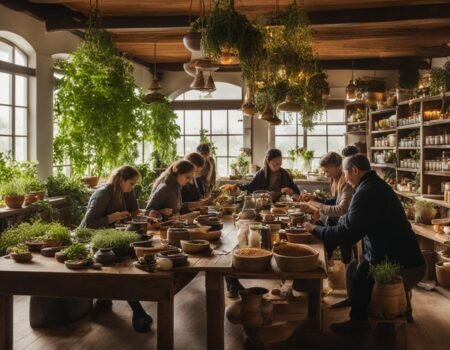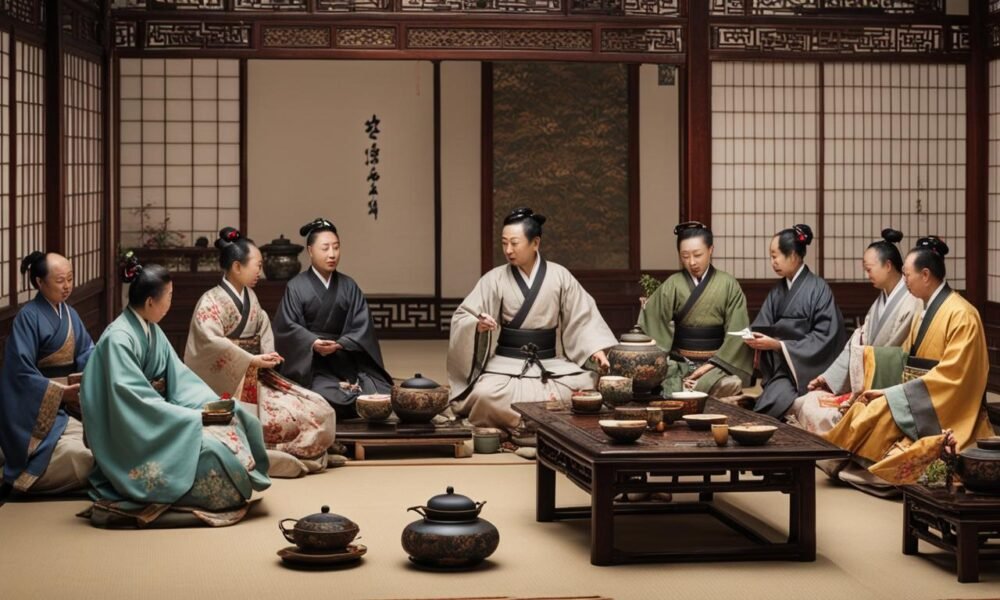
The Social Role of Tea Ceremonies in Chinese Culture Uncovered
Greetings! Today, we embark on a journey to unravel the fascinating social role of tea ceremonies in Chinese culture. Grab a cup of tea and join us as we delve into the captivating world of Chinese tea ceremonies and their impact on social events and gatherings.
Tea culture in China has a profound historical and cultural significance. It encompasses not only the cultivation, brewing, and serving techniques but also the beautiful art form known as the tea ceremony. These ceremonies hold a pivotal role in social events, where they foster harmony, elegance, and a sense of community.
Key Takeaways:
- Chinese tea ceremonies have a significant impact on social events and gatherings.
- Tea ceremonies foster harmony, elegance, and a sense of community.
- Chinese tea culture is deeply intertwined with the history and customs of Chinese society.
- The tea ceremony is an art form that showcases grace and beauty.
- Through tea ceremonies, individuals can connect with one another and cultivate a sense of unity.
The Evolution of Chinese Tea Culture over Time
Chinese tea culture has a rich and fascinating history that spans thousands of years. It has evolved through different phases, reflecting the social, cultural, and historical changes of Chinese society. The Chinese Tea Ceremony, in particular, has played a significant role in shaping the social dynamics and customs surrounding tea. Let’s delve into the journey of Chinese tea culture and its transformation over time.
Early Beginnings: Tea as Food
Tea cultivation in China dates back to ancient times, with the leaves initially consumed as food rather than a beverage. The discovery of tea’s medicinal properties led to its incorporation into traditional Chinese medicine practices. It was during the Tang Dynasty (618-907 AD) that tea drinking transitioned from a medicinal practice to a social ritual.
“Tea is the ultimate mental and medical remedy and has the ability to make one’s life more full and complete.” – Eisai, a Japanese Zen Buddhist monk
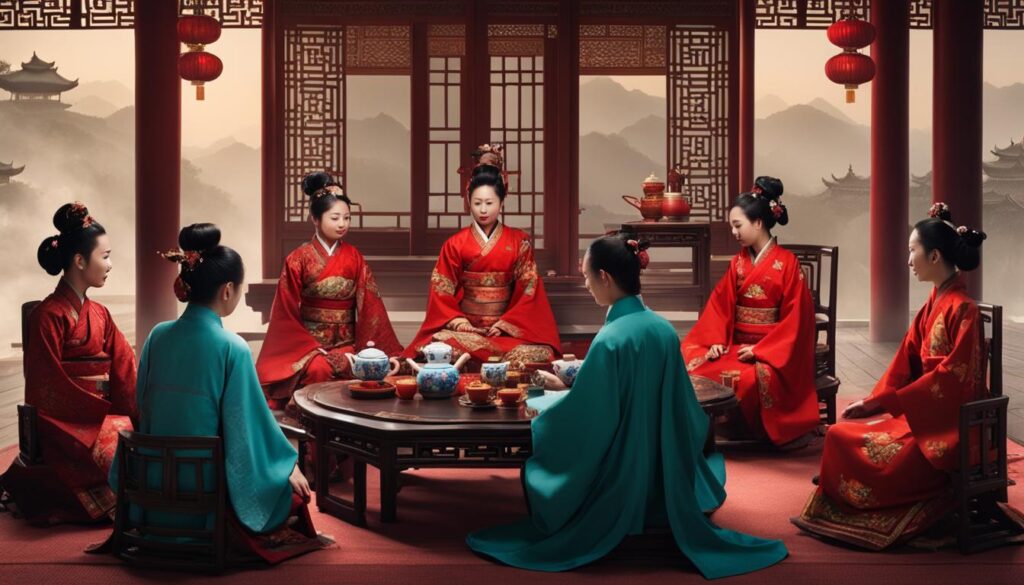
The Rise of the Tea Ceremony
As tea gained popularity, the Chinese Tea Ceremony emerged as a social ritual in the Song Dynasty (960-1279 AD). The ceremony became an art form that showcased grace, elegance, and respect for guests. It provided an opportunity for people to connect, share stories, and cultivate friendships.
The social dynamics within Chinese tea ceremonies were structured and hierarchical, reflecting the rigid social structure of ancient China. The host, often a respected figure, would prepare and serve the tea with meticulous attention to detail. Guests were expected to appreciate the tea and engage in meaningful conversations, contributing to the overall harmony of the gathering.
Modern Adaptations: Tea’s Role in Chinese Social Life
In contemporary Chinese society, tea ceremonies continue to hold cultural significance, although they have evolved to accommodate modern lifestyles. Tea houses and tea shops are now popular venues for social gatherings, where people can relax, socialize, and appreciate the art of tea. These spaces foster a sense of community and serve as a platform for cultural exchange.
Tea’s role in Chinese social life extends beyond the walls of tea houses. It is often served at important social events such as weddings, business meetings, and family gatherings. The act of serving tea symbolizes respect and gratitude, creating a meaningful connection between individuals and reinforcing social bonds.
The evolution of Chinese tea culture reflects the evolving nature of Chinese society. From its early origins as a medicinal food to the sophisticated art form it has become today, tea continues to be an integral part of Chinese social life, fostering harmony and a sense of community.
The Spiritual and Cultural Significance of Chinese Tea Ceremonies
Chinese tea ceremonies hold a deep spiritual and cultural significance in Chinese society. These ceremonies are often conducted during community events and social gatherings, symbolizing unity, respect, and harmony. Chinese tea ceremonies are seen as a way to connect with nature, cultivate the mind, and improve moral integrity. They are an expression of traditional Chinese culture and represent a form of art that encompasses poetry, calligraphy, and the appreciation of beauty and grace.
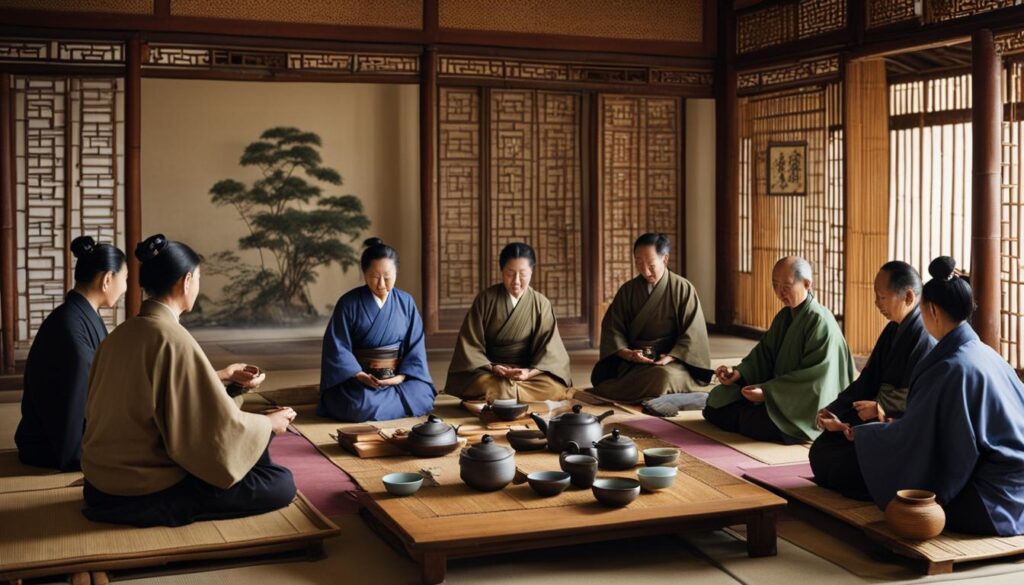
The social significance of Chinese tea ceremonies is rooted in their ability to bring people together and foster a sense of community. In these ceremonies, participants not only enjoy the taste and aroma of tea but also engage in a shared experience that promotes harmony and balance. Chinese tea ceremonies are an embodiment of the values and customs of Chinese society, emphasizing respect, humility, and appreciation for the present moment.
Through the centuries, Chinese tea ceremonies have become an integral part of Chinese social life, serving as a means of communication, social bonding, and relaxation. They provide a space for individuals to pause, reflect, and connect with others in a meaningful way. The act of preparing and serving tea in a ceremonial manner is a form of art that requires patience, precision, and attentiveness, further enhancing the overall experience and creating a sense of tranquility.
In conclusion, Chinese tea ceremonies play a vital role in Chinese culture, offering a spiritual and cultural connection that goes beyond the act of drinking tea. They provide a platform for individuals to come together, foster social harmony, and honor traditional values. Whether it’s a community event or a social gathering, Chinese tea ceremonies create an atmosphere of beauty, grace, and tranquility, allowing participants to immerse themselves in the rich tapestry of Chinese culture.
The Art and Technique of Chinese Tea Brewing
Chinese tea brewing is an art form that requires skill, precision, and an understanding of the unique characteristics of each tea variety. The brewing process is an integral part of the Chinese Tea Ceremony, adding an element of grace and beauty to the experience. Chinese tea sets, with their exquisite designs and craftsmanship, play a crucial role in enhancing the aesthetic appeal of the ceremony.
When it comes to Chinese tea sets, there is a wide variety to choose from, each with its own unique features. Clay teapots, known as Yixing teapots, are highly regarded for their ability to retain heat and enhance the flavor of the tea. These teapots are often adorned with intricate designs and are considered a work of art in themselves. Alternatively, porcelain tea sets are favored for their delicate beauty and are often used for more formal occasions.
During a Chinese Tea Ceremony, the brewing process is carefully choreographed. The water temperature must be precise, ensuring that it is neither too hot nor too cold, as this can affect the taste of the tea. The steeping time for each type of tea is also crucial, as it determines the strength and flavor profile of the brew. The selection of high-quality tea leaves is vital, as it directly impacts the overall experience.
The Brewing Process:
- Heat the water to the appropriate temperature for the type of tea being brewed.
- Warm the teapot and cups by pouring a small amount of hot water into them, then discard the water.
- Add the tea leaves to the teapot, using the recommended amount for the desired strength.
- Pour the heated water into the teapot and let it steep for the appropriate duration.
- Pour the brewed tea into small cups in a circular motion to ensure even distribution.
- Enjoy the tea, savoring its aroma, flavor, and the moment of tranquility it brings.
| Chinese Tea Sets | Description |
|---|---|
| Yixing Teapots | Clay teapots known for their heat retention and ability to enhance tea flavor. |
| Porcelain Tea Sets | Delicate and beautiful sets often used for formal occasions. |
| Glass Tea Sets | Made of transparent glass, allowing the visual appreciation of the tea’s color and clarity. |
| Bamboo Tea Sets | Natural and eco-friendly sets, perfect for a rustic tea experience. |
The art and technique of Chinese tea brewing bring people together, creating a sense of community and appreciation for the tea’s beauty and flavor. Chinese Tea Ceremonies, often held during social events and gatherings, provide an opportunity for individuals to connect with each other and with nature. By engaging in this ancient practice, participants can experience a moment of tranquility, balance, and harmony.
Conclusion
As we conclude our exploration of Chinese tea ceremonies, we cannot help but marvel at their profound place in Chinese social culture. These ceremonies go far beyond being a simple beverage; they are a cherished art form that brings people together, fosters harmony, and reflects the values and customs of Chinese society.
The tea ceremony is a beautiful expression of traditional Chinese culture, encompassing poetry, calligraphy, and the appreciation of beauty and grace. It serves as a way to connect with nature, cultivate the mind, and enhance moral integrity. Through the centuries, tea ceremonies have shaped the rich tapestry of Chinese culture and continue to be an integral part of Chinese social life.
From community events to social gatherings, Chinese tea ceremonies symbolize unity, respect, and harmony. They create a sense of elegance and a feeling of being part of a larger community. The tea ceremony’s place in Chinese social culture cannot be overstated; its importance is woven into the fabric of everyday life, providing a source of solace and a reminder of the values that bind us together.
So, the next time you sip on a cup of tea, take a moment to appreciate the artistry, history, and social significance that Chinese tea ceremonies bring. Each sip is a journey into a world where traditions are cherished, connections are forged, and the spirit of community thrives.
FAQ
What is the social role of Chinese tea ceremonies?
Chinese tea ceremonies play a pivotal role in social events and gatherings, fostering harmony, elegance, and a sense of community.
How has Chinese tea culture evolved over time?
The practice of tea-drinking has evolved from tea leaves being consumed as food to the development of the tea ceremony as a social ritual. Tea has played a significant role in Chinese social life, bringing people together and fostering a sense of harmony and balance.
What is the spiritual and cultural significance of Chinese tea ceremonies?
Chinese tea ceremonies symbolize unity, respect, and harmony. They are seen as a way to connect with nature, cultivate the mind, and improve moral integrity. Chinese tea ceremonies are an expression of traditional Chinese culture and represent a form of art that encompasses poetry, calligraphy, and the appreciation of beauty and grace.
What is the art and technique of Chinese tea brewing?
The art of Chinese tea brewing involves precise techniques, such as water temperature control, steeping time, and the selection of tea leaves. Chinese tea sets, with their exquisite designs and craftsmanship, are used to enhance the aesthetic experience of tea drinking.



